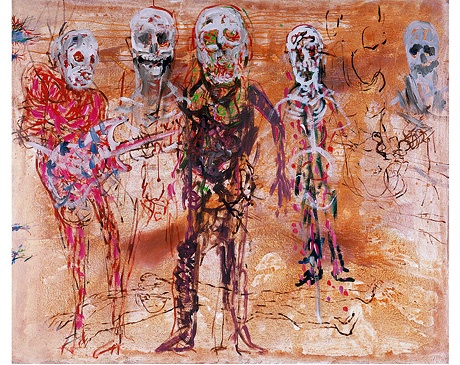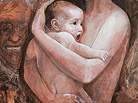Jiří Anderle — ‘View back and Forward’ cycle presentation

Ever since his earliest years Anderle has been a keen and astute observer of people, and his experiences have always taken on concrete artistic forms, with the key moments revolving around dance, drums and masks. If Anderle's pictures can be described as resonating with some kind of rhythmic internal energy, then his masked characters, dancers and drummer boys constitute a figurative materialisation of this quality. Just as on many previous occasions, an historical revelation is apparent in Jiří Anderle's visual interpretations. Having started with the motif of a primitive being, which is the most basic embodiment of man, Anderle once again returned to his concept of the camouflaged world just after the axioms of civilisation collapsed. His cycle New Age (2001-2002), created as if in a trance, is a fusion of a global picture of the world after 09/11, and the motifs taken from his private world.
One of the hallmarks of Jiři Anderle's artwork is his constant inspiration by primordial cultures, which were until very recently called ‘primitive’. This feature provides a dark and intuitive counterpoint to his expressiveness, which is set in the rational tradition of the Renaissance. Anderle has always been intensely interested in cultures and forms which are not part of the mainstream of Western art. Aside from primordial art, he is also fascinated with the forms created by ‘outsiders’, whose genuine spontaneity roughly corresponds with his own 'explicitly bare sensitivity' and ‘psychological automatism of imprinting’, as Anderle's idiomatic expression was once described by an art critic Jan Kříž. Anderle's passion for African primordial art, with its intensely powerful vividness and enchanting psycho-realism, evolved after the artist had assembled his own collection of artefacts from tribal art. Everyday confrontation with the poignant presence of these objects resulted in his desire to respond to their mute call and to blend his own energy with theirs. This dialogue brought about the newest cycle View Forward and Back (2002), in which specific ominous-looking objects compelled the artist to try and plumb their mystery using a painted canvas. This artistic dialogue with the objects of primordial art, which depicted a great human epic, was a cathartic experience for Anderle, and the questioning his own self constitutes a significant chapter in his work.
The exhibition was organised by the BWA Contemporary Art Gallery in Katowice, and included the first public presentation of Jiří Anderle's cycles New Age and View Forward and Back, which showed this artist as a master of synthesis, whereby the multiple and diverse elements of his pieces were integrated into a whole. Finally, Anderle's kaleidoscopic oeuvres referenced the inevitable complications relating to the different dimensions of human existence — the past and the present, the rational and the irrational, internal and external existences, as well as individual psyche and collective experience.
Richard Drury
With thanks to the city of Jelenia Góra, whose financial support made this exhibition possible.

‘Jiří Anderle. View Back and Forward’ ‘Over a period spanning some fifty years, the Czech artist Jiří Anderle has produced a large a varied body of work, including...

Jiří Anderle is a Czech artist of international renown, notable for his unusual ability to employ historical achievements of humanity, such as the profusion of ideas and means of expression, as well as focusing on the deepest recesses of our common heritage. His works derive from a myriad of conscious and unconscious images, merging the past with the present, describing human life in deep metaphors, and presenting the audience with a wide scope of moral standards, character traits and experiences. For over forty years of his artistic career, Anderle has created a plethora of varied graphic works, paintings and sculptures. Despite the great diversity of forms and techniques, Anderle's polyphonic art is characterised by a conspicuous and permanent feature — the basic humanistic concept, which ranges beyond the notions of specific time, place and cultural differences, and explores the most fundamental and universal problems with which humanity is fraught. Anderle seems to penetrate beyond the surface of the superficial and the ephemeral, as he expresses his feelings both at the intellectual and instinctive levels. He makes use of his own prolific concepts and impressions, designing pictures of metaphorical drama which transgress the dimension of internal viewpoint.




